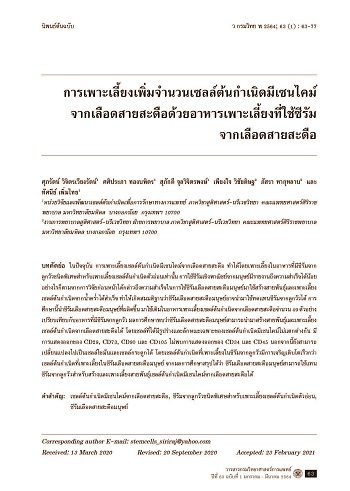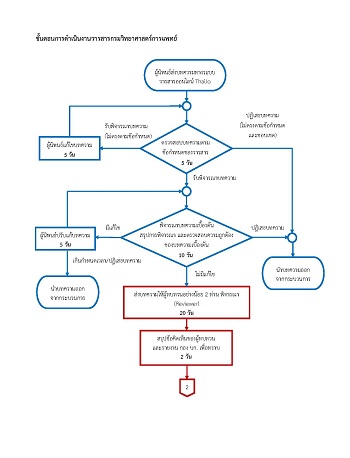การเพาะเลี้ยงเพิ่มจำนวนเซลล์ต้นกำเนิดมีเซนไคม์ จากเลือดสายสะดือด้วยอาหารเพาะเลี้ยงที่ใช้ซีรัมจากเลือดสายสะดือ
คำสำคัญ:
เซลล์ต้นกำเนิดมีเซนไคม์จากเลือดสายสะดือ, ซีรัมจากลูกวัวชนิดพิเศษสำหรับเพาะเลี้ยงเซลล์ต้นกำเนิดตัวอ่อน, ซีรัมเลือดสายสะดือมนุษย์บทคัดย่อ
ในปัจจุบันการเพาะเลี้ยงเซลล์ต้นกำเนิดมีเซนไคม์จากเลือดสายสะดือ ทำได้โดยเพาะเลี้ยงในอาหารที่มีซีรัมจากลูกวัวชนิดพิเศษสำหรับเพาะเลี้ยงเซลล์ต้นกำเนิดตัวอ่อนเท่านั้น การใช้ซีรัมเชิงพาณิชย์จากมนุษย์มีรายงานถึงความสำเร็จได้น้อย อย่างไรก็ตามจากการวิจัยก่อนหน้าได้กล่าวถึงความสำเร็จในการใช้ซีรัมเลือดสายสะดือมนุษย์มาใช้สร้างสายพันธุ์และเพาะเลี้ยงเซลล์ต้นกำเนิดจากนํ้า ครํ่าได้สำเร็จ ทำให้เกิดสมมติฐานว่าซีรัมเลือดสายสะดือมนุษย์อาจนำมาใช้ทดแทนซีรัมจากลูกวัวได้ การศึกษานี้นำซีรัมเลือดสายสะดือมนุษย์ที่ผลิตขึ้น มาใช้เติมในอาหารเพาะเลี้ยงเซลล์ต้นกำเนิดจากเลือด สายสะดือจำนวน 49 ตัวอย่าง เปรียบเทียบกับอาหารที่มีซีรัมจากลูกวัว ผลการศึกษาพบว่าซีรัมเลือดสายสะดือมนุษย์สามารถนำมาสร้างสายพันธุ์และเพาะเลี้ยงเซลล์ต้นกำเนิดจากเลือดสายสะดือได้ โดยเซลล์ที่ได้มีรูปร่างและลักษณะเฉพาะของเซลล์ต้นกำเนิดมีเซนไคม์ไม่แตกต่างกัน มีการแสดงออกของ CD29, CD73, CD90 และ CD105 ไม่พบการแสดงออกของ CD34 และ CD45 นอกจากนี้ยังสามารถเปลี่ยนแปลงไปเป็นเซลล์ไขมันและเซลล์กระดูกได้ โดยเซลล์ต้นกำเนิดที่เพาะเลี้ยงในซีรัมจากลูกวัวมีการเจริญเติบโตเร็วกว่าเซลล์ต้นกำเนิดที่เพาะเลี้ยงในซีรัมเลือดสายสะดือมนุษย์ จากผลการศึกษาสรุปได้ว่า ซีรัมเลือดสายสะดือมนุษย์สามารถใช้แทนซีรัมจากลูกวัวสำหรับสร้างและเพาะเลี้ยงสายพันธุ์เซลล์ต้นกำเนิดมีเซนไคม์จากเลือดสายสะดือได้
เอกสารอ้างอิง
Yao P, Zhou L, Zhu L, Zhou B, Yu Q. Mesenchymal stem cells: a potential therapeutic strategy for neurodegenerative diseases. Eur Neurol 2020; 83: 235-41.
Nishida F, Zappa Villar MF, Zanuzzi CN, Sisti MS, Camiña AE, Reggiani PC, et al. Intracerebroventricular delivery of human umbilical cord mesenchymal stem cells as a promising therapy for repairing the spinal cord injury induced by Kainic acid. Stem Cell Rev Rep 2020; 16(1): 167-80.
Jin MC, Medress ZA, Azad TD, Doulames VM, Veeravagu A. Stem cell therapies for acute spinal cord injury in humans: a review. Neurosurg Focus 2019; 46(3): E10. (11 pages).
Zang L, Hao H, Liu J, Li Y, Han W, Mu Y. Mesenchymal stem cell therapy in type 2 diabetes mellitus. Diabetol Metab Syndr 2017; 9: 36. (11 pages).
Hu J, Wang Y, Gong H, Yu C, Guo C, Wang F, et al. Long term effect and safety of Wharton's jelly-derived mesenchymal stem cells on type 2 diabetes. Exp Ther Med 2016; 12(3): 1857-66.
Gluckman E, Broxmeyer HE, Auerbach AD, Friedman HS, Douglas GW, Devergie A, et al. Hematopoietic reconstitution in a patient with Fanconi’s anemia by means of umbilical-cord blood from an HLA-identical sibling. N Engl J Med 1989; 321(17): 1174-8.
Broxmeyer HE. Insights into the biology of cord blood stem/progenitor cells. Cell Prolif 2011; 44(Suppl 1): 55-9.
Broxmeyer HE. Cord blood hematopoietic stem cell transplantation. In: StemBook. [online]. 2010; [cited 2020 Nov 9]: [13 screens]. Available from: URL: https://www.ncbi.nlm.nih.gov/books/NBK44751/
Phuc PV, Ngoc VB, Lam DH, Tam NT, Viet PQ, Ngoc PK. Isolation of three important types of stem cells from the same samples of banked umbilical cord blood. Cell Tissue Bank 2012; 13(2): 341-51.
Vu N, Bui A, Trinh V, Phi L, Phan N, Pham P. A comparison of umbilical cord blood-derived endothelial progenitor cell transplantation and mononuclear cell transplantation for the treatment of acute hindlimb ischemia in a murine model. Biomed Res Ther 2014; 1(1): 9-20.
Kim SW, Jin HL, Kang SM, Kim S, Yoo KJ, Jang Y, et al. Therapeutic effects of late outgrowth endothelial progenitor cells or mesenchymal stem cells derived from human umbilical cord blood on infarct repair. Int J Cardiol 2016; 203: 498-507.
Zhang X, Hirai M, Cantero S, Ciubotariu R, Dobrila L, Hirsh A, et al. Isolation and characterization of mesenchymal stem cells from human umbilical cord blood: reevaluation of critical factors for successful isolation and high ability to proliferate and differentiate to chondrocytes as compared to mesenchymal stem cells from bone marrow and adipose tissue. J Cell Biochem 2011; 112(4): 1206-18.
Dalle JH, Duval M, Moghrabi A, Wagner E, Vachon MF, Barrette S, et al. Results of an unrelated transplant search strategy using partially HLA-mismatched cord blood as an immediate alternative to HLA-matched bone marrow. Bone Marrow Transplant 2004; 33(6): 605-11.
Shim JS, Cho B, Kim M, Park GS, Shin JC, Hwang HK, et al. Early apoptosis in CD34+ cells as a potential heterogeneity in quality of cryopreserved umbilical cord blood. Br J Haematol 2006; 135(2): 210-3.
Fujii S, Miura Y, Iwasa M, Yoshioka S, Fujishiro A, Sugino N, et al. Isolation of mesenchymal stromal/stem cells from cryopreserved umbilical cord blood cells. J Clin Exp Hematop 2017; 57(1): 1-8.
Ben Azouna N, Jenhani F, Regaya Z, Berraeis L, Ben Othman T, Ducrocq E, et al. Phenotypical and functional characteristics of mesenchymal stem cells from bone marrow: comparison of culture using different media supplemented with human platelet lysate or fetal bovine serum. Stem Cell Res Ther 2012; 3(1): 6. (14 pages).
Julavijitphong S, Wichitwiengrat S, Tirawanchai N, Ruangvutilert P, Vantanasiri C, Phermthai T. A xeno-free culture method that enhances Wharton's jelly mesenchymal stromal cell culture efficiency over traditional animal serum–supplemented cultures. Cytotherapy 2013; 16(5): 683-91.
Phermthai T, Tungprasertpol K, Julavijitphong S, Pokathikorn P, Thongbopit S, Wichitwiengrat S. Successful derivation of xeno-free mesenchymal stem cell lines from endometrium of infertile women. Reprod Biol 2016; 16(4): 261-8.
Selvaggi TA, Walker RE, Fleisher TA. Development of antibodies to fetal calf serum with arthus-like reactions in human immunodeficiency virus-infected patients given syngeneic lymphocyte infusions. Blood 1997; 89(3): 776-9.
Tuschong L, Soenen SL, Blaese RM, Candotti F, Muul LM. Immune response to fetal calf serum by two adenosine deaminase-deficient patients after T cell gene therapy. Hum Gene Ther 2002; 13(13): 1605-10.
Ma HY, Yao L, Yu YQ, Li L, Ma L, Wei WJ, et al. An effective and safe supplement for stem cells expansion ex vivo: cord blood serum. Cell Transplant 2012; 21(5): 857-69.
Phermthai T, Odglun Y, Chuenwattana P, Julavijitphong S, Titapant V, Vantanasiri C. Successful derivation and characteristics of xeno-free mesenchymal stem cell lines from human amniotic fluid generated under allogenic cord blood serum supplementation. Tissue Eng Regen Med 2011; 8: 216-23.
Phermthai T, Thongbopit S, Pokathikorn P, Wichitwiengrat S, Julavijitphong S, Tirawanchai N. Carcinogenicity, efficiency and biosafety analysis in xeno-free human amniotic stem cells for regenerative medical therapies. Cytotherapy 2017; 19(8): 990-1001.
Musina RA, Bekchanova ES, Belyavskii AV, Grinenko TS, Sukhikh GT. Umbilical cord blood mesenchymal stem cells. Bull Exp Biol Med 2007; 143(1): 127-31.
Shetty P, Bharucha K, Tanavde V. Human umbilical cord blood serum can replace fetal bovine serum in the culture of mesenchymal stem cells. Cell Biol Int 2007; 31(3): 293-8.
Huang L, Critser PJ, Grimes BR, Yoder MC. Human umbilical cord blood plasma can replace fetal bovine serum for in vitro expansion of functional human endothelial colony-forming cells. Cytotherapy 2011; 13(6): 712-21.
Romanov YA, Vtorushina VV, Dugina TN, Romanov AY, Petrova NV. Human umbilical cord blood serum/plasma: cytokine profile and prospective application in regenerative medicine. Bull Exp Biol Med 2019; 168(1): 173-7.
Goodwin HS, Bicknese AR, Chien SN, Bogucki BD, Quinn CO, Wall DA. Multilineage differentiation activity by cells isolated from umbilical cord blood: expression of bone, fat, and neural markers. Biol Blood Marrow Transplant 2001; 7(11): 581-8.
Campagnoli C, Roberts IA, Kumar S, Bennett PR, Bellantuono I, Fisk NM. Identification of mesenchymal stem/progenitor cells in human first-trimester fetal blood, liver, and bone marrow. Blood 2001; 98(8): 2396-402.
Hunt CJ. Cryopreservation of human stem cells for clinical application: a review. Transfus Med Hemother 2011; 38(2): 107-23.
Yang SE, Ha CW, Jung M, Jin HJ, Lee M, Song H, et al. Mesenchymal stem/progenitor cells developed in cultures from UC blood. Cytotherapy 2004; 6(5): 476-86.
Shetty P, Cooper K, Viswanathan C. Comparison of proliferative and multilineage differentiation potentials of cord matrix, cord blood, and bone marrow mesenchymal stem cells. Asian J Transfus Sci 2010; 4(1): 14-24.
Sibov TT, Severino P, Marti LC, Pavon LF, Oliveira DM, Tobo PR, et al. Mesenchymal stem cells from umbilical cord blood: parameters for isolation, characterization and adipogenic differentiation. Cytotechnology 2012; 64(5): 511-21.
Yoshioka S, Miura Y, Iwasa M, Fujishiro A, Yao H, Miura M, et al. Isolation of mesenchymal stromal/stem cells from small-volume umbilical cord blood units that do not qualify for the banking system. Int J Hematol 2015; 102(2): 218-29.
Fan X, Liu T, Liu Y, Ma X, Cui Z. Optimization of primary culture condition for mesenchymal stem cells derived from umbilical cord blood with factorial design. Biotechnol Prog 2009; 25(2): 499-507.
Jochems CE, van der Valk JB, Stafleu FR, Baumans V. The use of fetal bovine serum: ethical or scientific problem? Altern Lab Anim 2002; 30(2): 219-27.
Zheng X, Baker H, Hancock WS, Fawaz F, McCaman M, Pungor E, Jr. Proteomic analysis for the assessment of different lots of fetal bovine serum as a raw material for cell culture. Part IV. Application of proteomics to the manufacture of biological drugs. Biotechnol Prog 2006; 22(5): 1294-300.

ดาวน์โหลด
เผยแพร่แล้ว
รูปแบบการอ้างอิง
ฉบับ
ประเภทบทความ
สัญญาอนุญาต

อนุญาตภายใต้เงื่อนไข Creative Commons Attribution-NonCommercial-NoDerivatives 4.0 International License.



